2020 Hyundai Tucson
Performance • Comparisons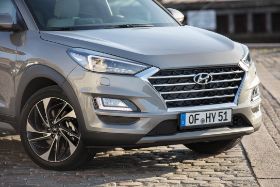
What’s New for 2020?
The Hyundai Tucson doesn’t get significant changes this year. 2019 saw a bevy of updates including new styling and safety features. 2020 brings some exterior color changes and a leather-wrapped steering wheel and shift knob as a standard feature on the Sport trim. 2021 will bring a new generation of the model with styling cues from the Vision T concept shown at last year’s Los Angeles Auto Show. The current model is handsome but conservatively styled. The next-generation Tucson will be anything but that.
SangYup Lee, head of the Hyundai Design Center, said last year that the design of the 2021 Tucson will “freak out,” people. If the latest renderings - based on design sketches and spy shots of camouflaged test mules - are accurate, the newest Tucson will look more like a $200,000 Lamborghini Urus than a $25,000 Hyundai. Buyers shouldn’t see the outgoing model as a consolation or leftover, though. Hyundai packs plenty of features and style into the 2020 Tucson at a price lower than its competition.
The Pros and Cons of the 2020 Hyundai Tucson
The Pros:
✅ It’s Stylish, but not Overstyled
The 2020 Hyundai Tucson looks good from every angle. The design is conservative, of course, but at the same time it’s not a style that will age poorly. Revolutionary designs tend to look old before their time. Body lines are clean and the 2019 refresh was a fine evolution of the 2016 redesign. Inside, it’s pleasantly laid-out. The tablet-style touch screen doesn’t look out of place like some others. Controls are placed “just so,” in the right place for the job.
✅ It’s Reliable
Hyundai has advanced by leagues since they entered the United States market some 35 years ago with the Excel. The 2020 Tucson reflects that with the tried-and-true Theta engine in 2.0- and 2.4- liter iterations, long-lasting six-speed automatic transmission, and 100,000-mile powertrain warranty to back them up. J.D. Power has the current-generation Tucson rated as a 4 for reliability on a scale of 5. Owner reviews reflect this as well, rating the Tucson at 85/100.
✅Safety First
Keeping safety a priority was a major reason for the 2019 redesign. For 2020, all trim levels of the Tucson come with driver assistance safety features like:
- Emergency Braking Assistance
- Lane Departure Warnings
- Lane-keep assist
- Adaptive cruise control.
These features helped the 2019 model become a Top Safety Pick from the Insurance Institute for Highway Safety. Since they’re all carried over for the 2020 model year, safety ratings haven’t changed. BlueLink is also included for three years and provides safety services like automatic crash notification and enhanced roadside assistance.
✅ It’s Full of Features, Especially for the Price
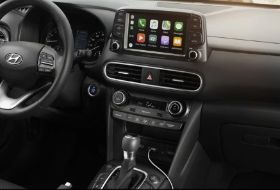
The base SE trim of the 2020 Hyundai Tucson is packed with features that are optional on some competitive models that cost more. A 7.0-inch touchscreen infotainment system is standard and comes with Apple CarPlay and Android Auto capability.
Alloy wheels are standard in 17- to 19-inch variants depending on trim and package, and they complement the style updates carried over from the 2019 facelift. The SE, Value, SEL, and Sport trim levels all have stain-resistant cloth that repels odors and static. For a family with kids, pets, or both, that’s a welcome addition.
Many of the competitors also have these features, but at a higher cost. For example, the base LE trim of the Toyota RAV4 has similar features but MSRP starts at $2,400 more than the Tucson SE. The 2020 Hyundai Tucson Limited has an MSRP $2,365 below a comparably equipped Nissan Rogue SL. To equip a Toyota Rav4 Limited as well as a Tucson Ultimate, it costs $2,580 more!
✅ It’s Backed by a Great Warranty
Hyundai trademarked the term, America’s Best Warranty, back in 1998 when they introduced the first Hyundai Advantage. It was revolutionary because it was the first 10-year, 100,000 mile warranty offered by a car manufacturer. In the years since, it’s expanded to become Owner Assurance. It’s the longest powertrain warranty in the industry, and carries a 5-year, 60,000 mile bumper-to-bumper warranty, but it also includes these benefits:
- Job loss protection for loans and leases
- Five years of roadside assistance coverage
- Three years of BlueLink coverage
- Three years or 36,000 miles of scheduled maintenance.
The Cons:
❌ It’s Not the Newest on the Market
The current Tucson has been around since 2016. That doesn’t make it the oldest compact crossover for sale, but of the 15 models jockeying for sales in this highly-competitive market segment, only the Rogue and Outlander Sport are older. The 2021 model will be all-new, so buyers who want the newest model should wait.
❌ Fuel Mileage Lags Behind the Competition
The Tucson’s fuel economy is not the best. The 2.0-liter front-wheel-drive is EPA rated at 23 city/28 highway/25 combined MPG, and adding all-wheel drive saps an extra three MPG from the highway figure. The 2.4 liter is almost the same, but with more power. EPA ratings are 22/28/25 for the front-wheel-drive and 21/26/23 for all-wheel drive. On the plus side, many tests by automotive journalists found that the Tucson performed better than its EPA ratings.
View more pros and cons of the 2020 Tucson. ›
Configurations / Trim Levels
The 2020 Tucson has five levels of trim ranging in price from about $24,000 to $34,000. As with most cars in its class, even the base model isn’t terribly basic. All trim levels of the Tucson have a host of safety features included, and all models include alloy wheels - something the more expensive Rogue and RAV4 don’t have. All-wheel-drive commands a $1,400 premium on all trim levels.
SE
The base Tucson SE comes well-equipped for a base model. Starting at $23,550 plus destination charges, it has the 2.0-liter Theta engine and 6-speed automatic. As stated above, the SE packs features into an inexpensive base model. Automatic projector headlamps, 17-inch alloy wheels, and YES-Essentials stain- and odor-resistant cloth seats round out the base package. In all, it’s a lot of features for not much money.
Value
The Value trim starts at a price of $25,000. For only $1,450 above the base SE’s MSRP, the Value trim adds many features that buyers want without adding a huge premium to the window sticker. Exterior-wise, the headlamps get LED accents, power mirrors are heated and roof rails are added.
Inside, the safety and comfort are stepped up a notch. Blind-spot and cross-traffic monitoring are added to electronic aids. The front seats are heated and the driver gets an 8-way power chair. The already good audio system adds BlueLink, HD radio and SiriusXM with a 3-month trial. The driver window is also upgraded to an auto up/down unit and proximity key with remote start rounds out the package.
SEL
The SEL at the middle of the range accounts for the most sales in the Tucson lineup. At $25,950, it’s priced the same as the less-equipped Toyota RAV4 LE. With a price tag of just $950 over the Value, it includes an array of upgrades.The most important of these is the engine. The SEL upgrades the powertrain to include the 2.4-liter Theta engine that’s shared with much of the Hyundai/Kia family.
Outside, the SEL gets a slightly revised front fascia and sills with brushed-metal-look plastic and a bit more chrome. 18 inch wheels are standard, an inch bigger than the SE and Value. Inside, the climate control system is upgraded to a dual-zone automatic unit with floor-mounted rear vents and a clean-air ionizer. Rear seat passengers get their own USB port in SEL and higher models.
Sport
Starting at $28,100 - a full $2,150 over the SEL - is the Sport model. Unique 19-inch alloys make a bold statement and lighting is upgraded to LEDs front and rear. Projector fog lamps are standard on the Sport trim and above, as is the hands-free power liftgate.
Inside, the Sport upgrades the sound system to an Infinity® unit with eight speakers including a subwoofer. A leather-wrapped steering wheel and shift knob are added as well, keeping with the Sport designation.
Limited
The Limited makes the shift from sport to luxury for a starting MSRP of $29,250. For the purpose of a softer ride than the Sport, the Limited has 18” alloy wheels with all-season touring tires. Inside, the seats get leather upholstery, the passenger seat gains 8-way power adjustment, and the leather-wrapped steering wheel is heated.
On the outside, it retains the LED lighting from the Sport and there’s a splash of chrome on grill accents. Door handles and window moldings are also chrome and the side mirrors gain turn signal indicators. As far as safety, the infotainment system adds a Surround View monitor that allows a 360-degree view of the car as it’s being parked.
Ultimate
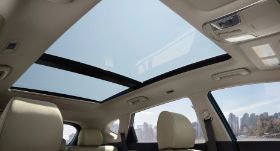
For a detailed comparison of these trim levels, see our recent research into the 2020 Hyundai Tucson Trim Level Comparisons and Configurations. ›
Driving Impressions and Performance
Initial Impressions
Part of the issue with designing a vehicle for mass appeal is that there’s often compromise with some part of the car. In the case of the 2020 Tucson, these compromises have been made with good results.
The 2020 Hyundai Tucson does a lot of things well. It’s comfortable, easy to get in and out of, and inexpensive. Driving the Tucson is neither drudgery nor exhilaration, and that’s how Hyundai designed it. The ride and handling are balanced to inspire confidence in drivers during the daily commute and enough comfort to ensure that the commute . Despite being one of the least expensive vehicles in its class, it doesn’t feel cheap.
PerformanceDropping the 1.6T and sporty 7-speed dual-clutch transmission left the Tucson with two competent but conservative powertrain choices. The six-speed automatic is a conventional transmission that pairs well with either engine. Neither engine offered in the 2020 Hyundai Tucson is a fire-breathing monster of power, but the 2.4 is a far better match for this car. It is, after all, a family vehicle, suited for hauling kids to school, practice, rehearsal, and recitals. The all-wheel-drive system is designed for extra traction in bad weather, or the occasional trip to the campsite. It’s not a race car or rock crawler, and that’s what many buyers appreciate about it.
The base SE and Value make do with the 2.0-liter engine rated at 161 horsepower and 150 lb.-ft. of torque. It’s a capable engine but acceleration in the 3,300-pound crossover is uninspiring. So equipped, the Tucson can tow a 1,500 pound trailer. It’s not much, but enough to get the personal watercraft to the lake for a day.
The other trim levels get the 2.4, which has plenty of power to keep up with traffic. With 181 horsepower and 175 lb.-ft. of torque, this engine has the grunt that most buyers expect. The extra 20 horsepower and 25 lb.-ft. of torque are welcome when merging on the highway or hauling a car full of people. With the bigger engine, towing is upgraded as well, to 2,000 lbs. Moving a studio apartment with a compact trailer can be done without a second vehicle.
Fuel EconomyUnfortunately for Hyundai, the Tucson stands at the low end of the ratings in its class. It’s far from a gas guzzler, but dropping the Eco model last year and the 1.6T engine didn’t help.
The Tucson is a bit heavy for the power of the 2.0, and delivers only 23/28/25 MPG in front-wheel-drive guise. With all-wheel-drive, it’s rated at 22/25/23. Upgrading to the bigger engine in the front-wheel drive model only costs one MPG city, and the highway/combined ratings stay the same. The all-wheel-drive 2020 Tucson with the 2.4 actually gets one more highway mile per gallon than the lower trims with the 2.0-liter engine, with a rating of 21/26/23. The 2.0 has to work harder to pull the Tucson around, so fuel mileage suffers.
Safety
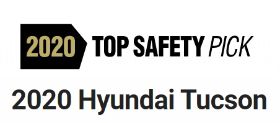
The Hyundai Tucson’s update for 2019 was focused on adding safety features and driver aids to the compact crossover. As such, it got an IIHS Top Safety Pick for that model year. It’s mostly unchanged for 2020, so safety is still a focus. In crash tests, NHTSA gave it a five-star rating overall with only the “side-pole” and “rollover,” crashes rating four stars out of five. Owners can drive confidently knowing their occupants will be safe in the unfortunate event of a traffic accident. When airbags do deploy, the car can automatically call for emergency services. With all of the features added last year, the Tucson deserves its safety awards.
Features such as emergency braking assistance, lane departure warnings and adaptive cruise control can often prevent crashes from happening in the first place, and the eight airbags inside the car help mitigate the possibility of serious injury. Other safety features that aren’t as obvious, like taut handling and good brakes, mean the driver can better control the vehicle in emergency situations.
Exterior Color Options
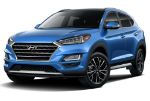



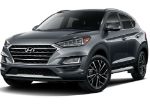




Reliability
When Hyundai first came to the North American market in the mid-1980s, they faced an uphill battle. The Excel had one thing going for it: a base price of $4,995. At the time, all of its competition was priced at least $1,000 higher. Hyundai was able to move nearly 200,000 of its only model during its first year. Unfortunately, they were poorly built, slow, and noisy. Many of them were in junkyards before the Clinton administration started. Hyundai got a reputation for being cheap and disposable.
This reputation has been wiped out by the company’s continual efforts to improve. The Theta engine and 6-speed automatic in the 2020 Hyundai Tucson have been used across the company lineup for years. With millions on the road, there are plenty of examples of the reliability of the powertrain that’s backed up with a 10-year/100,000-mile warranty. Beyond that, reliability ratings of Hyundai cars and crossovers have been continually above average for the past decade.
How Does It Compare
2020 Hyundai Tucson vs 2020 Hyundai Santa Fe
The Tucson is the smaller sibling to the Santa Fe in the Hyundai lineup, and many buyers might cross-shop these two because both are for sale on the same lot. The Santa Fe is bigger and more expensive than the Tucson, but they share a significant amount of DNA. The place where most buyers will see a big difference is cargo space - the Santa Fe has 35.9 cubic feet of cargo space behind the back seats to the Tucson’s 31.0. With the rear seats folded down, the Santa Fe has 71.3 cubic feet of space while the Tucson is limited to 61.9.
The Santa Fe is also offered with a 235-horsepower 2.0T engine that produces 260 lb.-ft. of torque. To get that engine, though, buyers have to step up to the SEL 2.0T with an MSRP of $34,725. The bigger Hyundai also includes the newer eight speed automatic and delivers the same fuel economy as the Tucson despite weighing 300-500 pounds more. The new eight-speed auto, however, should be arriving with the 2021 Tucson and it will have fuel economy numbers more in line with its competition.
See our In-Depth Comparison of the 2020 Tucson and the Santa Fe Here
2020 Hyundai Tucson vs 2020 Kia Sportage
The Kia Sportage shares a platform with the Tucson, but the two vehicles are notably different. While the Hyundai has subtly handsome looks, the Kia is gregarious. From the front, the current Sportage apes the muscular European style of the Porsche Macan. The Sportage also eschews the 2.0-liter Theta in favor of the more powerful 2.4, even in the base LX trim. The Sportage feels tighter inside, though.
Keeping with the European flair, only the base LX has cloth seats. The S and EX trim levels both come with Kia’s Sofino leatherette, a high-quality vinyl that mimics the feel of genuine leather. At the top of the range, the SX Turbo has all creature comforts plus the 2.0-liter turbo from the Santa Fe, but tuned to 240 horsepower. For a compact crossover, it’s downright fast. The Tucson’s Kia cousin went all out with the Sport part of its Sportage name.
See our In-Depth Comparison of the 2020 Tucson and the Sportage Here
2020 Hyundai Tucson vs 2020 Hyundai Kona
The Tucson’s smaller sibling is designed for a different buyer than the Tucson. If the Tucson is a skier, the Kona is a snowboarder. While the Tucson rides its inline skates for exercise, the Kona wears them to roller derby. Both are good at what they do. In the Hyundai crossover lineup, the Kona is funky, fun, and versatile, but also small. With front headroom nearly 2 inches less than the Tucson, taller drivers may be cramped.
The back seat of the Kona is suitable for shorter adults and children, while the Tucson has room in the rear to allow full-size adults to sit down. The Kona’s Limited and Ultimate trim also come with the 1.6t and 7-speed dual clutch transmission that was dropped from the Tucson lineup with the refresh last year. With 175 hp, 195 lb.-ft. of torque, and a curb weight fully 300-pounds less than its Tucson stablemate, the Kona is more “sport,” than “utility.”
See our In-Depth Comparison of the 2020 Tucson and the Kona Here
2020 Hyundai Tucson vs 2020 Nissan Rogue
The Nissan Rogue is a study in contrasts. It’s the #3-selling compact crossover, but it’s also regularly panned in the automotive press. It’s gone seven model years so far without a major update, so tooling and manufacturing costs are low. Yet it’s more expensive than the better-equipped Hyundai.
Driving the two vehicles, subtle yet important differences stand out. The Nissan’s transmission, a CVT unit, seems indecisive. Many automotive journalists have derided the Rogue’s transmission for being, in so many words, terrible. The conventional six-speed auto in the Tucson shifts quickly and with authority. The Nissan has more horsepower than the 2.0-liter in the Tucson yet it feels slower. It has better EPA fuel mileage ratings, but real-world testing leaves both vehicles about even.
The main advantage that the 2020 Rogue has over the Tucson is the fact that it’s got interior space closer to the Santa Fe. It offers an inch more headroom than the Tucson, and it has 39 cubic feet of storage behind the rear seats. Behind the front seats it offers 70.
See our In-Depth Comparison of the 2020 Tucson and the Rogue Here
2020 Hyundai Tucson vs 2020 Mazda CX-5
While looks are subjective, the Mazda CX-5 has garnered significant praise for its design. Many writers agree that it’s the best-looking compact crossover available. This is for good reason, too. Its long-hood, short-deck design mimics the grand-touring “Shooting Brakes,” of mid-century Europe. The depth of the color Soul Red II harks to Hot Rods, Kustoms, and Lowriders with their multi-layered, bright metallic paint jobs.
Inside, the seats are comfortable and the dash is attractive and well-laid out. The Mazda also offers a turbocharged 2.5-liter Skyactiv-G four cylinder, shared with the Mazda6 and CX-9. In the CX-5, it produces 227 horsepower and 310 lb.-ft. of torque. That’s more torque than the 6-cylinder engine in the Toyota Tacoma pickup truck. The beauty and power comes at a price, however. Expect to pay a $2,000 premium over the Tucson for a similarly-equipped CX-5.
See our In-Depth Comparison of the 2020 Tucson and the CX-5 Here
2020 Hyundai Tucson vs 2020 RAV4
The Toyota RAV4 is the current sales leader in the compact crossover market, and it’s easy to see why. It’s an excellent vehicle. It also started the compact crossover market in 1994. Sure, there were the Honda Civic WagoVan, Dodge Colt Vista, and the 4-wheel-drive Tercel wagons of the 80s, but those were decidedly niche vehicles that were popular among a few specific demographics. With the release of the RAV4 in the mid-90s, the compact crossover began to have mass appeal.
The current Toyota RAV4 was redesigned for the 2019 model year, with looks to bring it more in line with its truck and SUV lineup. It bests the Tucson in power with a 2.5-liter four cylinder engine that makes 205 horsepower. It also has more interior room with 37.6 cubic feet behind the rear seats and 69.8 cubic feet with the rear seats folded down. It’s significantly more expensive than the Tucson, though, and it doesn’t feel as much better as the price tag seems to imply.
See our In-Depth Comparison of the 2020 Tucson and the RAV4 Here
• 2020 Hyundai Tucson vs Hyundai Santa Fe
• 2020 Hyundai Tucson vs Kia Sportage
• 2020 Hyundai Tucson vs Hyundai Kona
• 2020 Hyundai Tucson vs Nissan Rogue
• 2020 Hyundai Tucson vs Mazda CX-5
• 2020 Hyundai Tucson vs Toyota RAV4
• 2020 Hyundai Tucson Prices. MSRP vs Invoice Price vs True Dealer Cost
• 2020 Hyundai Tucson Trim Levels and Configurations
• 2020 Hyundai Tucson Pros vs Cons

